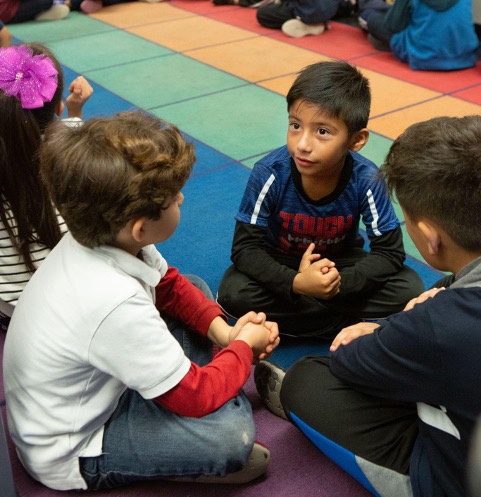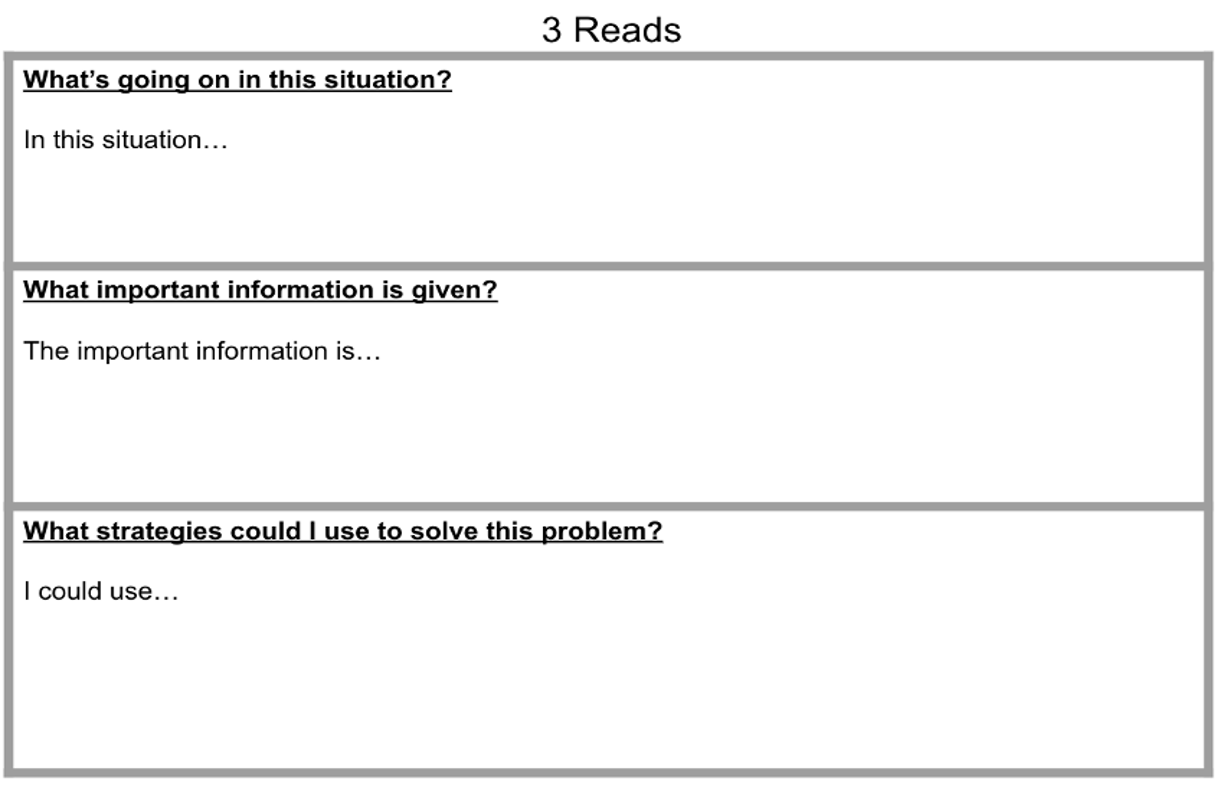Supporting Student Discourse after the COVID-19 Pandemic
by Amy Withers and Charlene Marchese
Do your students seem less enthusiastic about working in math groups or communicating their ideas and thoughts in class? If so, you are not alone. Teachers with whom we work are observing a decline in students’ skills to work together and express their thoughts. What has been the impact of the COVID-19 pandemic on students’ discourse? A great deal has been written about the impact of the pandemic on student learning, standardized assessment results, and students’ social skills (Mervosh & Wu, 2022, Associated Press, 2022, Campbell, 2021). However, little has been written about how students’ ability to communicate their mathematical understandings has been impacted. Anecdotal evidence suggests that the COVID-19 pandemic has impacted students’ abilities to develop mathematical discourse with their peers and communicate their mathematical understandings. This post will provide explicit structures and routines that can be used in classrooms to develop students’ ability to engage in productive mathematical discourse.

The importance of student communication in math classrooms is widely recognized (Stiles, 2016). Facilitating meaningful mathematical discourse is one of the Practices of Effective Teaching as outlined by the National Council of Teachers of Mathematics (2014): “Effective teaching of mathematics facilitates discourse among students to build shared understanding of mathematical ideas by analyzing and comparing student approaches and arguments.”
Student talk in math class boosts confidence and supports sense making as students explain, justify, and critique mathematical ideas. Even with abundant research that points to the benefits of student discourse, many math classrooms continue to be teacher-centered and have an over-reliance on the Initiation-Response-Evaluation (IRE) questioning. IRE is a routine in which a teacher poses a question, a student responds, and the teacher evaluates the accuracy of the response. The sudden transition to distance learning at the onset of the pandemic and the safety measures in place as we returned to in-person learning resulted in a decrease in students’ opportunities to communicate with one another. We now see an increased need to support students in developing their ability to engage in discourse.
Development of mathematical language is not separate from the development of mathematical ideas. As we develop our knowledge of language, we communicate our mathematical thinking; as we communicate our mathematical thinking, we develop mathematical language. Stanford University’s work on the interconnectedness of mathematical ideas and language is relevant to student discourse post-COVID-19 (Zwiers et al., 2017). Zwiers and colleagues developed four design principles based on the understanding that language and disciplinary knowledge are developed interdependently. Their four design principles are quoted here:
- Support sense-making: Scaffold tasks and amplify language so students can make their own meaning.
- Optimize output: Strengthen the opportunities and supports for helping students to clearly describe their mathematical thinking to others orally, visually, and in writing.
- Cultivate conversation: Strengthen the opportunities and supports for constructive mathematical conversations (pairs, groups, and whole class).
- Maximize cognitive meta-awareness: Strengthen the “meta-” connections and distinctions between mathematical ideas, reasoning, and language.
These design principles inform the research-based math language routines (MLR). We share three of these routines below to explore ways they can be embedded in math instruction and how they support student discourse. We had success implementing the MLRs with diverse learners, including multilingual learners. It’s important that in all MLRs, “talk-worthy” contexts are given to students to discuss!
MLR1: Stronger and Clearer Each Time. In this routine, students have a chance to share their thinking with two (or more) different partners before some students are selected to share with the whole class. In addition to sharing their own ideas, each student is also hearing the ideas of other students. This allows students a chance to rehearse their ideas and, perhaps, revise them as well after hearing from others.
In a classroom recently, one of the authors tried this out with a teacher who added a movement component to the routine. They had students stand up, raise one of their hands, then high-five a student in the class from a different table. This was the first partnership. Each student shared their thoughts about the given prompt. They had students move around the classroom a second time to “high-five” a different student. During this activity, the teacher walked around the room, listened to what students were sharing, and then selected and sequenced students to share with the whole group.
By expressing their ideas more than once, students are able to refine and revise their thinking as well as hear other students’ use of mathematical vocabulary in context. This routine provides multilingual students more than one opportunity to understand how to incorporate vocabulary into their own responses. While we didn’t use writing in this example, this routine can also be used with written responses. Students first write their ideas, then discuss with and hear from at least two partners, and then revise their writing. This activity also offers students time to rehearse what they want to share and gives the teacher the opportunity to hear from all students, even if only a few share to the whole group.
MLR5: Co-Craft Questions. In this routine, students are shown a talk-worthy image or mathematical situation, such as an image of two students each holding a plate with a different number of apples. Or a story can be used, for example: “Mary and John went fishing. Mary caught 10 fish. John caught more fish than Mary.”
In both cases, students are not given a specific question to answer. Rather, students generate mathematical questions they could ask about each situation. We like having students write down their questions as it allows us to monitor their thinking, then we choose a few students to share out. But it’s also possible to have them share ideas aloud after some quiet think-time. In either case, students compare the questions they generated with a partner before sharing them with the whole class. Crafting their own questions gives students ownership over the problem-solving process. It creates an expectation that we can and should ask (and then answer!) mathematical questions about the world around us. After sharing student-generated questions, we can ask students to choose one question to solve, or we can choose a question that all students can work on solving.
In both above-mentioned routines, students are asked to work with a partner or group. In Peter Liljedahl’s Building Thinking Classrooms (Liljedahl, 2021), he describes his research-based findings on effective classroom practices that enhance student discourse. He found that students in grades K–2 work best in pairs, and students in grades 3 and up work best in triads. After using various strategies to determine groups, he found that when visually random systems were used to determine groups, and groups were changed every hour/class period, student discourse increased (like students picking a numbered card as they entered the classroom and then pairing with others who selected a card with the same number). It was critical that students believed that groups were randomly assigned and were given time to gel. After three weeks, students were willing to work with anyone they were placed with and “after six weeks almost 100% of students said they were likely or very likely to offer an idea” (pp. 45–46) in a small group, up from 20% prior to the visually random groups.
MLR 6: Three Reads. This routine supports students in slowing down and making sense of the mathematical relationships before jumping in to search for an answer.
- During the first read, students read the problem and their job is to summarize the situation, capturing the gist of the problem. For example, after reading a story problem, a student might say, “This story is about someone buying shoes.”
- After the second read, students state the important quantities and information. For the above example, students might say, “The two pairs of shoes cost $90.00 together” or “One pair of shoes was double the cost of the second pair.”
- In the third read, the question is revealed, and students then brainstorm strategies that could be used to solve the problem. Examples of strategies might include using money to count out the amount spent or making a table that reflects the price of each pair of shoes and the total cost.
We have used a simple graphic organizer, like the one shown below, as a place for students to jot down responses after each read. We have used this strategy successfully in supporting students to prepare for assessments, including standardized assessments.

Each of these examples asks students to share their thinking (in writing, orally, or both), as well as to listen to and make sense of their classmates’ thinking. Similar to the talk-worthy contexts mentioned above, it is critical that students are given rich open-ended tasks to explore using the Three Reads routine. It is important for all students, particularly our multilingual learners, to be given the opportunity to explain and justify their math reasoning. By providing students with these highly structured opportunities to share their thinking, we are supporting them to build their capacity to engage in mathematical discourse in more unstructured ways, and we are intentionally supporting their development of mathematical language.
We’ve only explored three of the eight MLRs. To learn more about these MLRs and explore the rest, see the summaries on Achieve the Core.
As you implement these routines, it might be helpful to have a partner. Reach out to your colleagues to see who would be interested in trying out these MLRs. In Math For All, we strive to meet the needs of all students, and we believe that teacher collaboration is critical to that goal. Collaboration can occur in planning meetings where you discuss which routines make sense for a given lesson or task to support all students.
What has been your experience with student discourse since the pandemic started? What support for discourse have you found effective as we return to the new normal? Is the pressure of “catching students up” from unfinished learning decreasing the opportunities for student discourse? If so, let’s remind ourselves that engaging all students in mathematical discourse every day will not only deepen their mathematical and linguistic knowledge, but it will strengthen their ability to communicate and connect with their peers.
References
Associated Press. (2022, September 1). Reading and math scores fell sharply during pandemic, data show. National Public Radio.
Campbell, L. (2021, October 31). Impact Of Covid[KP6] -19 on children’s social skills. Forbes.
Liljedahl, P. (2021). Building thinking classrooms in mathematics: 14 teaching practices for enhancing learning, grades K-12. Corwin Press, Inc.
Mervosh, S., & Wu, A. (2022, October 24). Math scores fell in nearly every state, and Reading dipped on national exam. New York Times.
National Council of Teachers of Mathematics. (2014). Principles to actions: Ensuring mathematical success for all.
Stiles, J. (2016). Interactive STEM, research + practice brief: Supporting mathematical discourse in the early grades.
Zwiers, J., Dieckmann, J., Rutherford-Quach, S., Daro, V., Skarin, R., Weiss, S., & Malamut, J. (2017). Principles for the design of mathematics curricula: Promoting language and content development. Stanford University.
The contents of this blog post were developed under a grant from the Department of Education. However, those contents do not necessarily represent the policy of the Department of Education, and you should not assume endorsement by the Federal Government.
This work is licensed under CC BY-NC-SA 4.0
Math for All is a professional development program that brings general and special education teachers together to enhance their skills in
planning and adapting mathematics lessons to ensure that all students achieve high-quality learning outcomes in mathematics.
